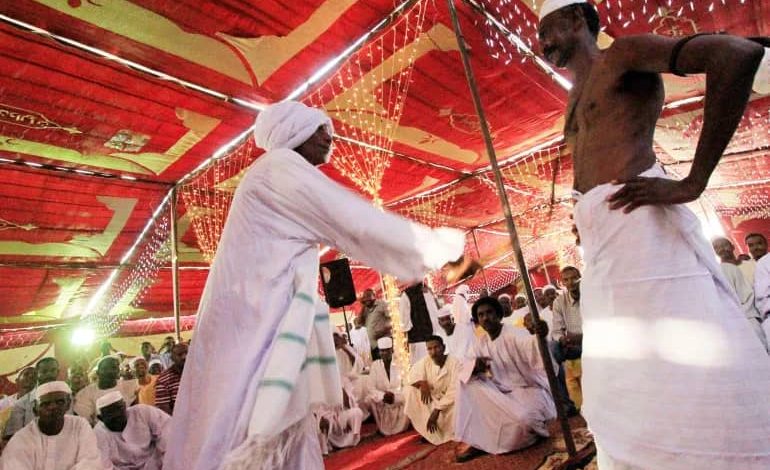Sudanese Tradition of Whipping, Stands the Test of Time

Sudan Events
Whipping is a source of pride and competition for young people in ceremonies.
Many wedding ceremonies in different countries have different traditions. In Sudan, it is whipping. Known locally as ‘Al-Potan’, it is a traditional and customary practice for some Arab tribes, notably the Ja’alin in the north of the country to maintain the tradition at weddings.
In fact, whipping young men has now become a fundamental part of all kinds of celebrations.
Traditionally, friends of the groom line up side by side, each resting on a rod and in a position to be lashed on their bare backs, either to demonstrate their appreciation to the groom or to pay an old lashing debt.
‘Al-Potan’ is not without pain, blood and difficulty. But there is no room in it for tears, movement or shaking. That is why every young man ensures maximum stability and no blinking even when the whip gets into his back and shoulders, regardless of the pain or bleeding.
According to Independent Arabia , No one is quite sure when it first started, but many assume that it goes back to the 1930s and 1940s, although some studies point back to a tradition much further back.
A member of the civil court and an elder of the Ja’alin tribe in El Matamma in the state of River Nile, Sheikh Mouktar Salem says that ‘Al-Potan’ represents the cultural heritage of the region’s population.
Salem said: whipping means patience and chivalry and we have chosen the lash as an instrument of execution, as it is safer, more hurtful and quite different from the rod which can cause death or serious harm.
Promoted stories:
“As far as the lash is concerned, it is made out of tar-infused animal skin to give it flexibility and a painful sting. It should be of a particular length so it will not crack while whipping. Its decorated handle makes it unique as compared to the ordinary lash used by shepherds. Previously, there was a category of people known as executioners. They were specialised in whipping during wedding ceremonies, and they had to know all about how and where to whip without causing harm or a disability”.
He added: “In the past, whipping was harsher and more painful. It was not confined to the shoulders and back as it is these days.
There are many different types of whipping. There is honorific whipping, courtesy of the groom in weddings; intimidation whipping, which takes place between two people until one of them surrenders; revenge whipping between whoever has a lashing debt to another; and finally, the competitive whipping to support the pursuit of excellence and win admiration, and that’s what normally happens in wedding ceremonies with the aim of catching a girl’s eye”, says Salem.
Men from the tribe are whipped as a sign of their strength and to show their dignity while experiencing pain
Today’s generation has different perceptions of whipping. According to university student Husam Farouk, ‘Al-Potan’ is a sign of underdevelopment, as it relies on strength and physical endurance to demonstrate confidence and chivalry.
According to Abbas Ahmad Al Hajj, a researcher in Sudanese cultural heritage, ‘Al-Potan’ is a tradition and a heritage that is linked to preparations for war, as well as raising strong and proud generations that do not fear pain ,Independent Arabia concluded.



